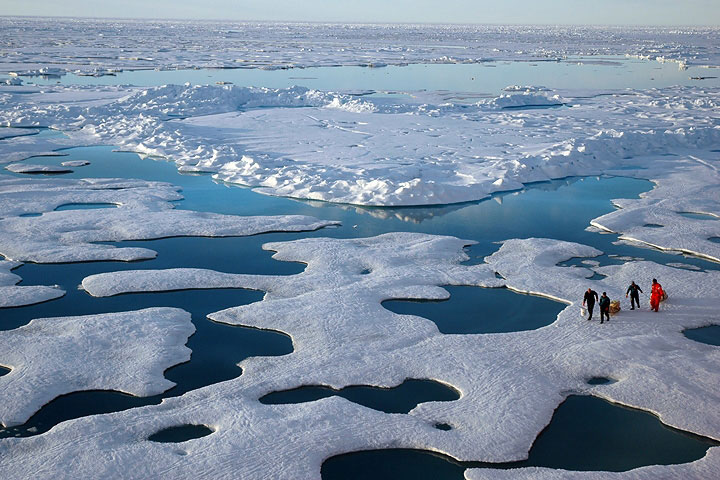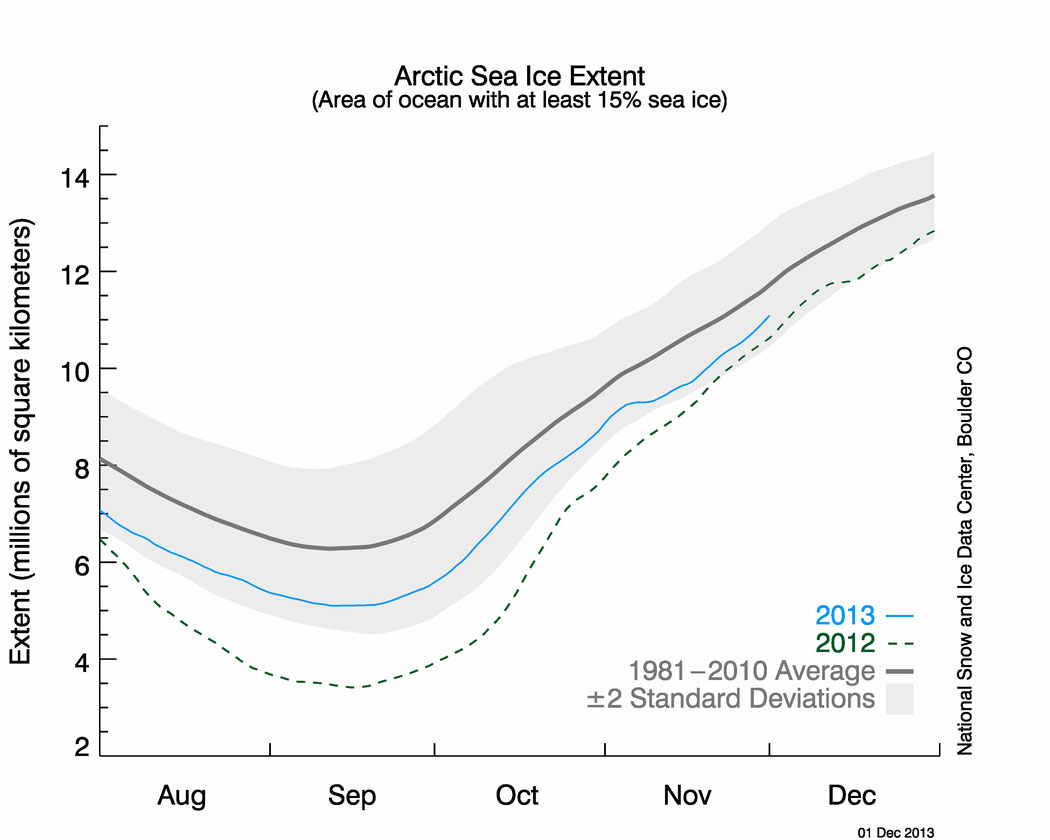Editor’s note: We have reposted and updated this story with additional links to various scientific studies, 2013 Arctic sea ice extent numbers, and quotes from industry on their use of sumps for disposal of waste.

TORONTO – Autumns are now longer and warmer than they once were in the Arctic, and the first cases of sunburn were reported to researchers by Inuit in Tuktoyaktuk, according to a study on the effects of climate change on the Inuit culture.
In the same study, Canadian Inuit Perspectives on Climate Change, Inuit reported skinnier and less healthy caribou, as a caribou food source — lichen — is becoming more difficult to get to due to winter freezing-rain events. The Inuit said it is more difficult to hunt as animals change their migration patterns.
“Climate change is already having very detrimental impacts on the Arctic environment, including melting permafrost leading to the collapse of buildings and houses, ‘drunken’ forests, disappearing sea ice (and with it, loss of the environment that is home to the walrus and polar bear), and massive disturbance of ecosystems,” Michael Mann, distinguished Professor of Meteorology at Penn State University and author of the book The Hockey Stick and the Climate Wars told Global News.
“In this sense, what is happening now in the Arctic provides a glimpse of our future, it is a harbinger of more devastating impacts to be seen here at lower latitudes.”
It is this variability and unpredictability that is making life in the Arctic more difficult.
Three recent studies back up those claims: according to these studies (including one in November from journal PLoS One), permafrost is thawing, releasing methane into the atmosphere and changing the vegetation.
The permafrost problem
Some of the biggest effects of climate change can be seen in the northern ecosystems.
Take the Mackenzie Delta, for instance.
The delta is home to large populations of fish, caribou, and other animals. But it is also rich in petroleum resources.
In the 1970s and ’80s, petroleum companies sought to determine exactly how much oil and gas lay beneath the surface. In doing so, they drilled test sites around several areas of the Mackenzie Delta. Once testing was completed, the companies covered the massive pits, creating sumps. They believed that the permafrost would keep the saline water used in the drilling in a permanent state.
However, with climate change, the permafrost is no longer so permanent.
If the Arctic continues to warm as it has been, it will continue to thaw permafrost, creating melt ponds.
For an enlarged map, click here.
In fact, in some areas, this is already happening.
These thaw ponds can leach the saline solution into the ground and surrounding natural ponds.
READ MORE: Thaw ponds unaccounted source of greenhouse gases
A recent study conducted by researchers at Queen’s University, Brock University, the University of Ottawa, Carleton University and the Northwest Geoscience Office examined the effects of these sump thaws.
“We had 101 lakes, 20 of them had sumps in them…what the petroleum industry left behind,” said John Smol, professor of biology Queen’s University and Canada Research Chair in Environmental Change. “And 34…had obvious thaw slumps, which means permafrost falling apart.
“Looking at the water chemistry, it was quite clear that many of the lakes that were in close proximity to the petroleum industry sumps, had higher salinity or higher chloride concentration,” said Smol.
“And the question was…if they’re falling apart, what does that mean to the local ecology?”
They determined that lakes downhill from these sumps had higher concentration of salt — as high as four or even 15 times the norm.
They also found that the saline fluid had already changed microscopic invertebrates in one lake, an important source of food in the aquatic ecosystem.
The concern is, if saline is leaking into the water affecting the ecosystem, there may very well be concentrations of other material with unknown consequences.
- Life in the forest: How Stanley Park’s longest resident survived a changing landscape
- ‘They knew’: Victims of sexual abuse by Ontario youth leader sue Anglican Church
- Roll Up To Win? Tim Hortons says $55K boat win email was ‘human error’
- Carbon rebate labelling in bank deposits fuelling confusion, minister says
The Importance of the Arctic
The Arctic, a sprawling area of ice and snow-covered land, is seeing changes that some studies suggest haven’t occurred in more than 100,000 years.
Temperatures are rising, sea ice is melting, vegetation is changing.
A few years ago, it was the polar bear that was the face of climate change in the Arctic.
But it’s not just these giant white bears whose lives are under threat.

According to Unikkaaqatigiit: Perspectives From Inuit In Canada, hunters are also finding the changing weather patterns to be more difficult to predict: hundreds of years of being able to read the weather has become almost impossible.
In some areas, storms are becoming more frequent, wind directions are changing, and more thunderstorms are occurring. In other areas, there is lower precipitation and there are fewer storms.
The effects are widespread. Species that once lived farther south are slowly encroaching on the area; species that once called the tundra or ice home, have slowly begun to diminish in numbers.
According to the National Oceanic and Atmospheric Administration, in 2012, the sea ice extent was 3.41 million square kilometres, the lowest of the satellite era.
That was 18 percent lower than in 2007, where the sea ice was 4.17 million square kilometres.
In 2013, the Arctic ice showed some rebound with 5.10 million square kilometers (as of September). However, it was still well below the 1981-2010 average if 6.22 million square kilometres.
READ MORE: Why climate change deniers believe global warming isn’t a problem, and why experts say they’re wrong
The Arctic plays an essential role in our climate. Its white surface reflects sunlight, bouncing that heat back into space. This helps moderate Earth’s climate.
When Arctic snow or ice melts, it exposes the darkness of the water, which in turn absorbs the sunlight rather than reflect it, which warms the atmosphere.
And then it becomes a vicious cycle: more warming causes more melting. More melting causes more warming.
When the atmosphere warms, it also melts the snow cover on land. It has cascading consequences on the environment around it.
Permafrost thaws, and plants and animals that were once frozen in the ground decay, releasing carbon dioxide and methane, contributing to further warming.
The Arctic is warming at twice the rate of the rest of the planet. Many climatologists believe that summer in the Arctic will soon be ice-free.
READ MORE: Japan dials back climate change emissions target
“Most climate models predict ice-free late summer conditions in the Arctic in 50-60 years,” said Mann. “But this is one of many examples where the models may be far too conservative in their predictions.”
“There are many scientists who have studied what is happening in the Arctic who are convinced that we will see seasonally ice-free conditions in the Arctic in only a matter of a decade or two, given the ‘death spiral’ trajectory the ice is on,” Mann said.
“And there is reason to believe that the models may indeed me missing some key physics that prevents them from adequately representing real-world processes that are acting to accelerate the loss of Arctic sea ice.”
What this means for the future
Thawing permafrost and melting sea ice provides challenges for the future: wildlife will have to adapt to warmer temperatures; hunters will need to adjust their hunting seasons; homes will have to be rebuilt; drilling companies will have to find better disposal solutions.
In fact, drilling companies have already abandoned their practices of disposing of waste in sumps.
“There are very few left,” said John Hogg, vice president, Exploration and Operations at MGM Energy Corp. “A number of the sumps from the initial work in the ’70s and ’80s have been removed.”
MGM has been the only partner operating in the Mackenzie Delta since 2007.
“And,” said Hogg, “We said no sumps.”
Though some believe that the jury is still out on the science of climate change, the impacts of a warming Arctic that are already being felt can’t be ignored.
“Uncertainty is not an argument for inaction,” said Mann. “Uncertainty may very well end up weighing against us: the impacts and threat of climate change, in this and perhaps many other cases, may be worse than the models are currently projecting.”








Comments